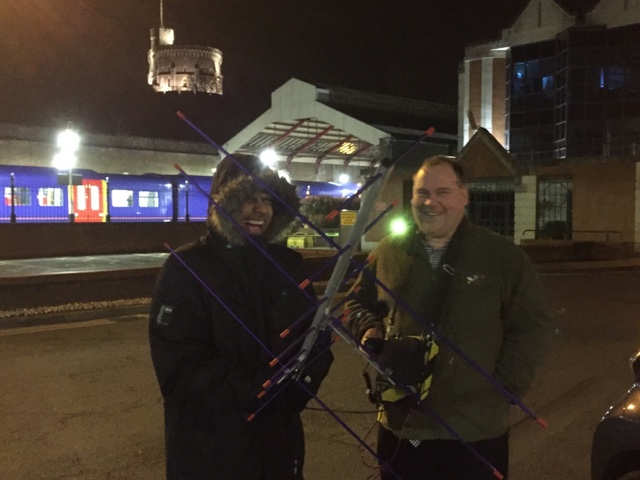Check the satellite status first
To check the status / mode of a satellite, please use this link http://www.amsat.org/status/Some satellites switch between data and transponder (repeater) modes.
This will save disappointment when all you hear is data, when you wanted a qso, or vice versa.
Note these SSB satellites DO NOT use CTCSS tones
You can download a chirp file here
In the charts below you will notice that transmit (UP) is always lower side band (LSB)
So it makes sense that Receive (DOWN) is always upper side band (USB)
It is highly recommended, if not required when operating SSB satellites to use 2 radios so you can hear your downlink, and not tread on anyone's toes or cause interference. It will also greatly help find your in and out frequencies.So please be considerate, operate well, listen lot's.
If you do not have 2 radios for full duplex operation, it is possible to work satellites using semi-duplex. However this is reserved for expeditions, or rare occasions where 2 radios is just not practical. Its frowned upon in the satellite community and causes issues.
These issues as you will hear frequently on the FM satellites include the operator calling CQ repeatedly and not able to hear the reply or calling out over the top of someone as there were not aware they were there. Just like on a normal repeater these habits are bad practice and cause frustration to others users, imagine missing that rare square or locator due to someone shouting cq over the top of you and just as the satellite pass finishes.
DON'T call CQ, listen and respond, if no one is around call sign sat (call /sat...)
a general qso is hello call, this is call your signal report 5/9 my locator IO67AS.
Short and simple, should be able to get a few in one pass, but if you have to ask the operator to repeat this takes up valuable time.
If you really have the need to work semi-duplex (Please don't)
How do I set the radio up to do split frequency / mode?
We only have access to a Yeasu 817 and 859, so We will include the instructions below, happy to add more makes and models as needed if it helps.Yeasu 857D and Yaesu 817
Press the [FUNC] key momentarily, then rotate the SELECT knob, as needed, until Multi Function Row “a” [A/B, A=B, SPL] appears on the display.
Now press the [A](A/B) key to toggle between the “A” and “B” VFOs.
As an example for FO-29 set VFO "A" as 435.850 LSB Down / receive
Press [A](A/B) will move you to VFO B and set the frequency to 145.950 USB
Press [A](A/B) again to return to the VFO A
Press [C](Split) do a test TX and check that you RX on 435 and TX on 145
You are now ready to try Sats, change the up / down frequency for each Sat
Listen several times before you attempt to transmit
As with all good radio practice, get used to the new mode and operating style before attempting a CQ call or QSO. SSB satellites are a little bit tricky to receive initially, especially if you are going to tune manually (which we are). Using your favorite satellite tracking software work out where about the pass is, and point the antenna in that general direction. Using our example of FO-29, start at 435.850 and tune *slowly* either side of that until you hear a qso, this may be Morse or Voice. See how the signal drifts up or down the band, tune to adjust for this (Doppler effect). Get used to this slow tuning technique, it will be needed in the next stage when you are ready to transmit.— Chertsey Radio Club (@chertseyRC) March 21, 2017Peter 2e0sql on FO-29 its not easy initially tuning !
FO-29 #morse 7:49 pass 27 degrees pic.twitter.com/N2A9njdky6— Chertsey Radio Club (@chertseyRC) March 21, 2017
Morse code heard on FO-29
Attempting your first SSB QSO on Satellite
Once you have a good grasp of listening and tuning to follow a conversation, its time to try and call CQ. The charts below give you a rough idea of where you transmit and where you should be heard.On FO-29, you transmit on 145.950 and should be heard around 435.850 +/-
Arranging a schedule with a more experienced sat operator, will be good idea on your initial go, they will be able to find you and respond (thanks Peter 2E0SQL).
So once the satellite is overhead, start calling CQ on the center frequency 145.950, give about 15-20 seconds, this allow the receiver to find and tune in to you. When you stop transmitting listen for a response, tune a small amount either side and see if you can find someone calling back to you.
Following what is referred to as, click the link for an in depth discussion, the one true rule
The best approach is to tune on the higher frequency band (UHF / 70cm / 435.x)
For FO-29 and AO-7 (Mode A),You will adjust RX frequency, as this is the higher frequency used.
If you get a response, put into practice what you learnt above and tune slowly to get the best reception.
However, on the other satellites where the Frequencies are reversed we need to tune the TX frequency as this is on the higher frequency
Using the charts below, they help give you a rough idea of where you TX and where you should be heard.
Bob M6FLT and Ian 2E0IPP at Windsor Castle having just worked FO-29, 5 watts Yeasu 817 and arrow antenna.
We want to hear how you get on
We are keen to hear how you get on tracking and working satellites and would be happy to share pictures, sound recordings and videos. We are on Twitter @chertseyrc and via e-mail jamesm0jfp@virginmedia.comHere are several charts to help you with the SSB satellites kindly provided by Paul K5PAV













